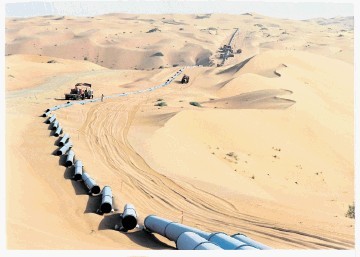
Oil was steady as analysts said a supply glut that’s driven prices to the lowest level in more than five years will linger through the first half of 2015.
Crude has dropped by more than half since June as US output surged and the Organization of Petroleum Exporting Countries decided to maintain its production ceiling.
Saudi Arabia won’t cut its output, though producers outside the group are welcome to do so, Ali Al-Naimi, that country’s oil minister, said at a conference in Abu Dhabi last month.
“The Saudis are providing no support for the market,” Helima Croft, chief commodities strategist at RBC Capital in New York, said by phone.
“It looks like they will let prices continue to fall, taking as much non-OPEC production offline as possible.”
Oil’s collapse has been so rapid and so driven by sentiment that forecasters from Bank of America Corp. to UBS AG say there are no clear signs of when the rout will end.
The US is pumping the most crude in more than three decades as horizontal drilling and hydraulic fracturing unlock shale reserves, adding to a global supply glut that Qatar estimates at 2 million barrels a day.
West Texas Intermediate for February delivery slid 7 cents to $48.58 a barrel at 11:44 a.m. on the New York Mercantile Exchange.
Futures touched $46.83 yesterday, the lowest level since April 2009. The volume of all futures traded was 6.3% above the 100-day average for the time of day.
Brent for February settlement decreased 39 cents to $50.76 a barrel on the London-based ICE Futures Europe exchange. It touched $49.66 yesterday, the least since April 29, 2009.
The European benchmark oil traded at a $2.39 premium to WTI on the ICE, the least since October.
US output expanded to 9.14 million a day through December 12, the highest level in weekly data from the Energy Information Administration that started in January 1983.
Credit Suisse Group AG cut its forecast for this year’s increase in U.S. crude output by 500,000 barrels a day, David Hewitt, the co-head of the bank’s global oil and gas equity research, said at an investor conference in Singapore today.
Growth may slow by 800,000 barrels a day in 2016 compared with its previous estimate, he said.
Credit Suisse had previously expected US production to accelerate by 1.3 million barrels a day in 2015, and 1.4 million next year, he said.
Brent crude will average $75 a barrel this year and $80 in 2016, according to Hewitt.
US crude exports climbed 34 percent to 502,000 barrels a day in November, the most in records dating back to 1920, data from the Census Bureau and the EIA show.
Some lawmakers in Washington are seeking to end a 40-year-old law that restricts crude sales to just a few overseas markets.
WTI rose as much as 2.1% earlier on speculation central banks will support growth even as the American economy shows signs of strength.
The Bloomberg Consumer Comfort Index increased to 43.6 in the week ended January 4, the highest level since October 2007, from 42.7 the period before, according to data issued.
A Labor Department report showed fewer workers filed for unemployment benefits last week.
“We are being torn in different directions,” said Phil Flynn, senior market analyst at the Price Futures Group in Chicago.
“On the one hand you have strong economic data, and on the other hand you have strong supply.”
Gasoline futures slipped 0.4% to $1.332 a gallon. Ultra low sulfur diesel rose 0.2% to $1.7039.
Regular gasoline at US pumps fell to the lowest level since May 2009.
The average retail price slipped 0.9 cent to $2.182 a gallon yesterday, according to Heathrow, Florida-based AAA, the nation’s biggest motoring group.
Pump prices were around $2.05 a gallon when oil was last below $50 a barrel.
Recommended for you
